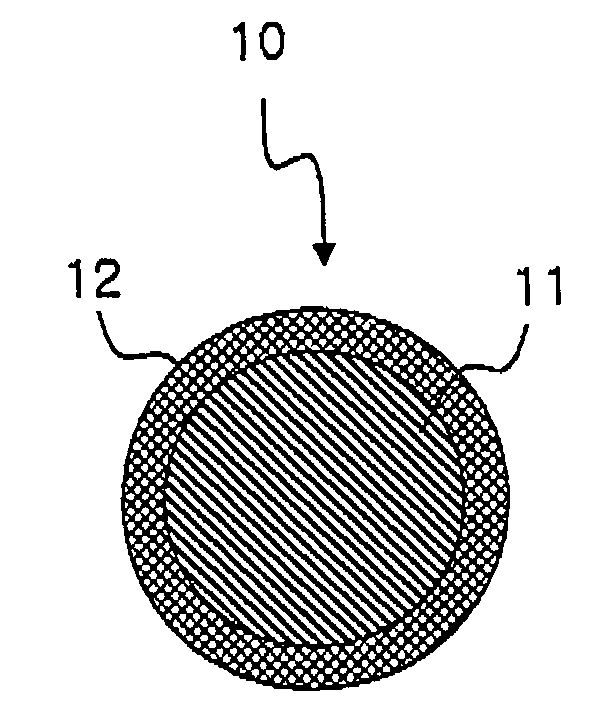Method for preparing a photochromic nanoparticle and nanoparticle prepared therefrom
a photochromic nanoparticle and nanoparticle technology, applied in the field of photochromic nanoparticles, can solve the problems of short life time, reduced stability of photochromic dyes, and decrease of stabilizer content as time goes by, and achieves the effect of maintaining transparency and easy production process
- Summary
- Abstract
- Description
- Claims
- Application Information
AI Technical Summary
Benefits of technology
Problems solved by technology
Method used
Image
Examples
examples [UNK]
EXAMPLES 1˜6
EXAMPLE 1
[0072] To 10 g of toluene were added 0.2 g of polystyrene having weight average molecular weight of 150,000, 0.08 g of a photochromic dye (Palatinate Purple, James Robinson) and 0.2 g of a surfactant (Triton x-100) to prepare a polymer solution. A surfactant (Tween 40) was dissolved in water at the concentration of 3 wt % to prepare 100 g of surfactant solution. The polymer solution and the surfactant solution were mixed and treated with a homogenizer for 2 minutes to prepare a micrometer sized emulsion. The emulsion was treated with a microfluidizer three times to give a nano-emulsion. The size of the nano-emulsion was measured with a particle size analyzer (UPA 150, Microtrac), and as a result, 170 nm sized nano-emulsion was prepared.
[0073] The nano-emulsion aqueous solution was filled in a plastic bottle and stood at zoom temperature (25° C.) for 2 days with the lid off to evaporate toluene. The content of toluene in the nano-emulsion was measured by gas ch...
example 2
[0076] A photochromic nanoparticle was prepared by the same manner as described in Example 1 except that polydimethylsiloxane (weight average molecular weight; 37,000) was used instead of polystyrene. The mean diameter of the photochromic nanoparticle before forming the silicate shell was 40 nm and the thickness of the silicate shell was confirmed to be up to 10 nm.
example 3
[0077] A photochromic nanoparticle was prepared by the same manner as described in Example 1 except that a polymer solution was prepared by adding 10 g of polystyrene (weight average molecular weight: 150,000), 2 g of a photochromic dye (Palatinate Purple, James Robinson) and 0.8 g of a surfactant (Triton x-100) to 30 g of toluene.
[0078] The mean diameter of the photochromic nanoparticle before forming the silicate shell was 80 nm and the thickness of the silicate shell was up to 9 nm.
PUM
| Property | Measurement | Unit |
|---|---|---|
| Temperature | aaaaa | aaaaa |
| Nanoscale particle size | aaaaa | aaaaa |
| Nanoscale particle size | aaaaa | aaaaa |
Abstract
Description
Claims
Application Information
 Login to View More
Login to View More - R&D
- Intellectual Property
- Life Sciences
- Materials
- Tech Scout
- Unparalleled Data Quality
- Higher Quality Content
- 60% Fewer Hallucinations
Browse by: Latest US Patents, China's latest patents, Technical Efficacy Thesaurus, Application Domain, Technology Topic, Popular Technical Reports.
© 2025 PatSnap. All rights reserved.Legal|Privacy policy|Modern Slavery Act Transparency Statement|Sitemap|About US| Contact US: help@patsnap.com



